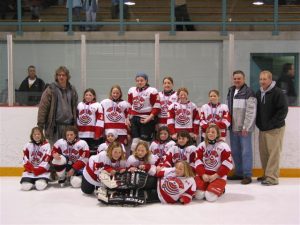After Chapman posted about the Humboldt Broncos’ terrible bus crash, I thanked him because, I didn’t know what else to say.
 I’ve been playing, coaching and even sometimes administering local hockey for 51 years, and this stuff strikes deep into any parent who has swerved on a snow-covered Canadian road only to listen to the kid (me) complaining, ‘we need to get there.’
I’ve been playing, coaching and even sometimes administering local hockey for 51 years, and this stuff strikes deep into any parent who has swerved on a snow-covered Canadian road only to listen to the kid (me) complaining, ‘we need to get there.’
Chapman wrote, “I often tell people that all I really know is hockey, food safety and family; everything and everyone important to me falls in one of those buckets. …
“All I could think of is all the teams I have been part of, back to when I was just a kid until now. Those experiences have meant so much more than competition and sport.
“It’s exactly why I got into coaching.”
No. Chapman got into coaching because I was his graduate supervisor, and his responsibilities included helping to coach a 6-9-year-old girls rep hockey team from Guelph, and bailing me out of jail upon request.
(He will say he was coaching before, but it probably wasn’t as much fun).
In 2005, Chapman and I came up with barfblog.com, and the first post was about hockey and barfing.
The worst was when I was 10 or 11. I was playing AAA hockey in my hometown of Brantford Ont., and we were off to an out-of-town game. My parents (bless them) usually drove, but obligations meant I had to get a ride with a friend on the team. About half-way to the arena, I started feeling nauseous. I tried to ask the driving dad to pull over, but it came on so fast, I had to grab the closest item in the backseat, an empty lunchbox.
I filled it.
And more.
Back in the 1970s, the coach’s main concern was that we win. I was the starting goaltender almost every game, while the backup sat on the bench. We had something to prove because we were from Brantford, the city that had produced Wayne Gretzky just a couple of years earlier and everyone was gunning for us.
I tried to get myself together to play. No luck. We got to the arena and I promptly hurled.
And again.
I couldn’t play, and, unfortunately, couldn’t go home. So the rest of the team went out for the game, as I lay on a wooden bench in a sweat-stenched dressing room, vomiting about every 15 minutes.
Whenever I spark up a conversation with a stranger, and they discover I work in food safety, the first response is: “You wouldn’t believe this one time. I was so sick” or some other variation on the line from American Pie, “This one time, at band camp …”
But the stories of vomit and flatulence are deadly serious. In 1995, a 5-year-old died in Wales as part of an E. coli O157:H7 outbreak that has sickened some 170 schoolchildren. Four people in the Toronto region were sickened with the same E. coli several weeks ago after drinking unpasteurized apple cider. Over 20 people are sick with the same bug from lettuce in the Minnesota area. And so it goes.
How did my game end? I could hear the various cheers but was lost in dizziness and nausea and sweat, wondering when this would end.
The trip home was uneventful; I was drained — figuratively and literally.
We lost.
Thanks to all the Australians I hung out with today and asked me about the Humboldt Broncos’ and hopefully I provided some insight into the role of (ice) hockey in the small and large communities throughout Canada.


